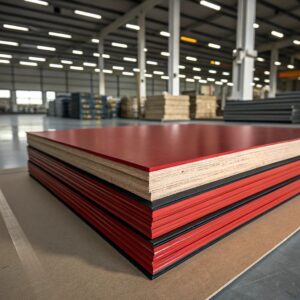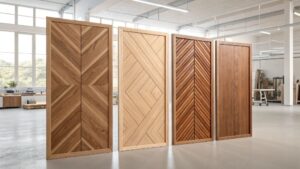
Veneer cutting styles have a big impact on how the final wood panel looks. As a manufacturer and exporter of melamine wood-based panel boards, I often talk with buyers around the world about how to pick the right veneer cut for their products. It may sound simple, but each cut changes the final texture, pattern, and even the cost of the panel. In this article, I will share what I know about the four most common veneer cuts. I will also explain how each one fits different furniture and design needs.
1.Crown Cut Veneer

Crown cut is one of the most popular cuts. It is made by slicing a log parallel to a line through its center. The result is a wide pattern that looks like a cathedral or a flame. The grains are open and flowing.
This cut works well for large surfaces like cabinet doors or table tops. I often recommend crown cut1 to buyers who want a natural look with strong grain patterns2. In some markets like South America and Africa, it is a top-selling option for residential furniture.
Why I Choose Crown Cut for Warm and Natural Designs
Crown cut has a special visual style. The patterns are soft but bold. It creates a feeling of warmth and flow. When I first started exporting panels to the Middle East, one of my clients requested a more "welcoming" look for hotel furniture. I showed them a few samples of crown cut veneer with different melamine finishes. They chose one with a walnut tone and crown pattern. It became their best-selling panel for two years.
The reason crown cut is so common is because of how it balances price and pattern. It uses more of the log than quarter or rift cut, which keeps the cost lower. That matters to many of my wholesale clients. They want decorative panels that look premium, but still fit their pricing model.
I also find crown cut easy to customize. At ACEALL, we can laminate these veneers with different finishes—matte, high gloss, even textures that mimic real wood pores. This helps brand owners offer unique designs, even when using the same base veneer. And with our eight production lines, we can offer stable supply in large volume, even during the busy season.
2.Quarter Cut Veneer

Quarter cut is made by slicing the log at a right angle to the growth rings. The result is a straight, linear grain that looks neat and clean. This cut is popular in modern and minimal styles.
It is often used in office furniture, kitchen cabinets, and hotel interiors. The grain is narrow and even, which makes it easy to match in larger projects.
Straight Grains for Structured Projects
Quarter cut is a smart choice for buyers who want a formal or modern look. One of my Canadian clients, Cathy, owns a company that imports panels and resells them to local furniture makers. She once told me, "My customers like order and clean lines. That’s why I prefer quarter cut."
When we started working together, I suggested a quarter cut oak veneer laminated with white melamine. It became one of her top-selling lines. The grain matched well across different furniture pieces. Her customers liked how everything looked consistent and high-end.
Quarter cut is also better for stability. Because the grain is straight, it reduces the chance of warping. That matters in places like Canada, where temperature changes can affect wood.
Here's a quick comparison:
| Feature | Crown Cut | Quarter Cut |
|---|---|---|
| Grain Pattern | Curved/Flowing | Straight/Linear |
| Use Case | Tables, Doors | Cabinets, Offices |
| Visual Impact | Warm/Natural | Modern/Clean |
| Cost | Moderate | Higher |
For me, quarter cut veneers represent precision. They are not always the cheapest, but they are consistent, professional, and ideal for buyers who value a refined appearance.
3.Rotary Cut Veneer

Rotary cut is made by spinning the log against a blade, like peeling an apple. This method produces the highest yield because it uses nearly the whole log.
The grain is large, open, and less uniform. This cut is common in plywood and panels that don’t require fancy patterns.
When Cost and Efficiency Matter Most
I talk with many buyers in Africa and South America who work on big volume projects—like housing or government furniture programs. In these cases, they need low-cost panels with solid durability. Rotary cut veneers help meet this demand.
Rotary cut doesn't produce perfect symmetry. But that’s not always a bad thing. For buyers who want a rustic or raw look, the natural variation adds charm. I had one client in Chile who wanted “unpolished” looking panels for rustic dining tables. We used rotary cut veneer with a dark brown finish. It looked just right.
Another plus is that rotary cut allows for fewer joints. The veneer sheet can be very wide—perfect for big surfaces. That reduces the need for gluing or joining multiple strips. It saves time and reduces error in production.
This cut also keeps the price low. That gives wholesalers more room to work with their own profit margins. If a customer asks for the best price per square meter, rotary cut is usually the answer.
4.Rift Cut Veneer
Rift cut is a precise method used mostly on oak. The log is sliced at a slight angle to the growth rings. The result is a tight, even grain with minimal variation. It often looks like parallel lines.
Rift cut is the most expensive method. But it’s also the cleanest in appearance. I recommend it for luxury furniture and projects where every detail matters.
Premium Projects Deserve Rift Cut
Rift cut is not for every buyer. But for those looking for top-end results, it is hard to beat. I worked with a client in Europe who designed executive desks and high-end kitchen systems. They were very strict about uniform patterns. We used rift cut white oak with ultra-matte finish. The final look was so smooth that you could barely see where one panel ended and the next began.
This cut also performs well in large batch projects. It’s easier to match grain direction across many sheets. That consistency is a big selling point for brand owners who want to protect their design quality.
One thing to keep in mind: Rift cut produces more waste from the log, which is why it costs more. But for buyers who understand the value of clean aesthetics, the cost is worth it.
Here is how it compares with quarter cut:
| Feature | Quarter Cut | Rift Cut |
|---|---|---|
| Grain Pattern | Linear | Uniform/Parallel |
| Visual Texture | Natural variation | Clean and smooth |
| Common Use | Offices, kitchens | Luxury desks, hotels |
| Price Level | Mid to high | High |
At ACEALL, we can produce rift cut veneers with fine detail. Our lamination tech supports high-definition wood grain printing, which makes the final product even more appealing.
5.Conclusion
Each veneer cut has its own purpose. Some offer rich patterns. Others bring order and smoothness. As a panel board factory with global clients, I see how different markets ask for different finishes. My job is to help importers and brand owners pick the cut that fits their customers best. Whether you want warmth, precision, economy, or luxury, there is a veneer cut for you. And we are ready to produce it for you at ACEALL.



